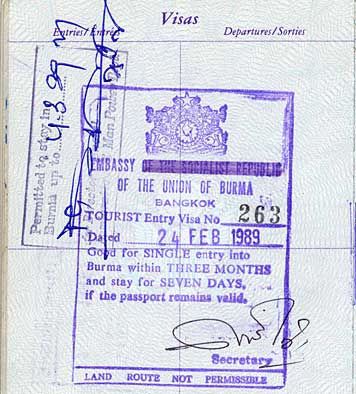
William Drenttel, passport, 1989
According to Wikipedia: 8888 Uprising was a national peaceful revolution demanding democracy that started on August 8, 1988, in Burma (now Myanmar), when university students started the initial demonstrations in Rangoon. The Uprising ended on September 18, 1988, after a bloody military coup by the State Law and Order Restoration Council (SLORC). Thousands, mostly monks and civilians (primarily students) were killed by the Tatmadaw (Burmese armed forces).
I spent a month in Asia in early 1989, and was fortunate enough to purchase an entry visa into Burma from Thailand. On February 24, 1989, my passport was stamped number 263, meaning the Burmese government admitted less than 300 tourists that month. Only four months earlier, the military regime had killed an estimated 3,000 civilians during the 8888 Uprising.
This slideshow of photographs from 1989 is dedicated to the people of Burma — as they again confront one of the most brutal regimes in the world.
A few notes and comments:
During my visit, the country was still known as Burma, and it's largest city was named Rangoon. In June 1989, SLORC adopted the name "Union of Myanmar." This name was recognized by the United Nations, but not by the U.S. or U.K. governments. Rangoon was simultaneously renamed Yangon. In November 2005, the military junta began relocating the capital to Naypyidaw, which was officially named as the new capital in March 2006.
These images are amateur tourist photographs. Hopefully, something of the beauty of Burma is evident nonetheless.
There are virtually no people in these photographs: my entire visit was state-supervised and I was frequently warned that my camera would be confiscated if I was caught taking pictures of people. Therefore these images are effectively censored of the people of Burma.
In some of the photographs, the temples are white. After the uprising, the military regime decided to cleanse the country, and many temples were whitewashed in December 1988-January 1989. Numerous temples were closed during my visit because of "wet paint." [See image no. 18 in the attached slideshow where the temple and the ground around it have been spray-painted white.]
At the Shwedagon Pagoda in Rangoon, my guides pointed out stains in the pavement where blood marked the killings from only months before. I cannot confirm the veracity of these statements, although killings on this site have been confirmed. This is again the site of massive demonstrations: "On September 24, 2007, 20,000 monks and nuns (largest protest in 20 years) marched at the golden Shwedagon Pagoda, Yangon... On September 26, 2007, clashes between security forces and thousands of protesters led by Buddhist monks in Myanmar have left at least five protesters dead by Myanmar security forces, according to opposition reports."
While in Rangoon, I stayed at The Strand. It was suitably rundown to qualify as a venue in a Graham Greene novel, including the bedbugs and foot-long lizards. It did not have a fancy website offering first-class accommodations in 1989.
These photographs have sat in a slide box in a drawer since 1989. I also visited Thailand during the same trip, and I am fearful that some images of Thailand may be among those I am representing as Burma. I apologize in advance for any mistakes. It is not my intent to confuse Burma and Thailand — it has been many years since my visit. Corrections are welcome.

